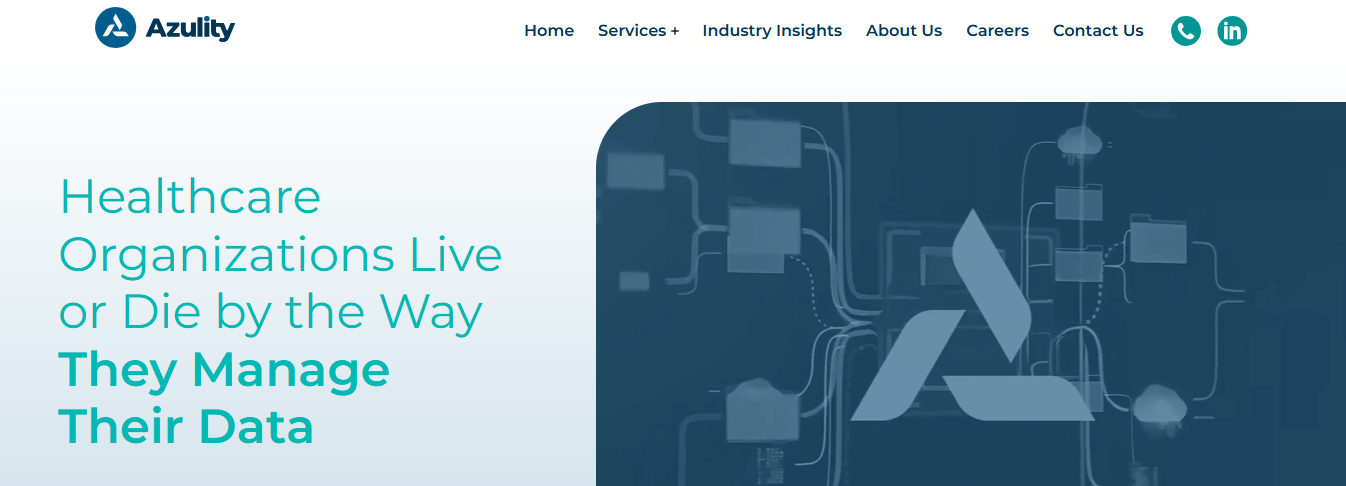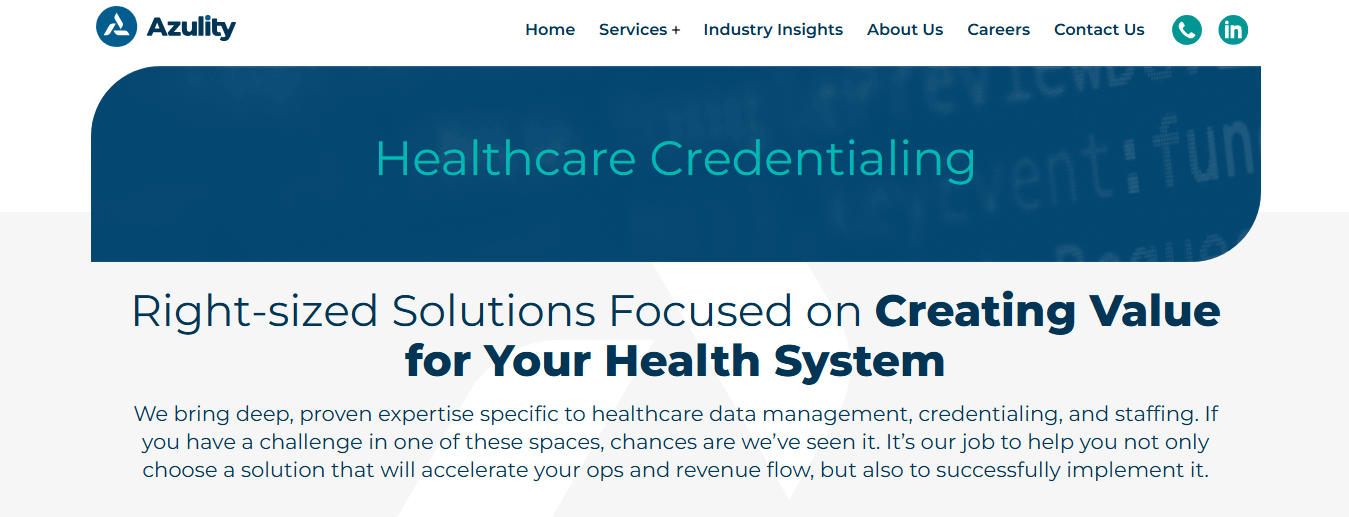Consider this: A patient arrives at your clinic hoping to receive care for a troubling condition. But your team figured out that the doctor they were assigned has an expired license. Credentialing can be tedious, but it’s crucial for patient safety and your organization’s compliance.
The healthcare credentialing workflow can be incredibly complicated, with many moving parts and multiple stakeholders involved.
This guide will show you how to do credentialing in healthcare, allowing your organization to have efficient credentialing processes that improve patient safety and organizational compliance.
Azulity’s provider credentialing services can help you achieve this. We simplify credentialing to reduce patient care delays and improve your organization’s performance.
Importance of Healthcare Credentialing


Credentialing Boosts Patient Confidence
The state of mind of your patients plays a significant role in the healing process. Patients who trust their physicians can feel better about following doctor’s orders, from changing diet and exercise to trying a new medication or undergoing a procedure. Of course, patients confident in their doctors will also be more likely to stay with the practice and won’t be looking around for a more competent physician.
Having fully medically credentialed nurses and doctors makes your organization more appealing to other employees, from new physicians, PAs, LVNs, RNs, nurse practitioners, and support staff. They’ll want the prestige that comes from knowing colleagues are all well-trained and up to speed on the latest in the medical industry. You encourage future excellence by highlighting the current outstanding abilities of your team.
Credentialing Establishes Your Professionalism
It’s best to demonstrate professionalism in a healthcare setting with irrefutable documentation. Taking the time to fill out the paperwork required to show your credentials is a small price to pay for being able to assure patients of your bona fides. Healthcare Innovation noted, “Through a standardized process involving data collection, primary source verification, and committee review by health plans, hospitals, and other healthcare agencies, patients are assured of their healthcare professional’s merit and experience.”
In the past, medical professionals may have balked at credentialing because of all the paperwork they’d have to wade through. However, modern methods allow much of this information to be handled online. Check that your team can use electronic credentialing for any entities that want to check your standing, such as before you start a contract with another organization or before any hospital can allow you to become an affiliate.
Details to provide include where you went to medical school, the location of your internship or residency, your board certifications, and your curriculum vitae. Of course, you’ll also note information about the malpractice insurance that I carry and your current, valid medical license.
Credentialing is Required for Compensation
You’ll need to be medically credentialed, as this is required for reimbursement from insurance companies. Getting the documentation finished promptly ensures that a new nurse or doctor I’ve hired can begin providing services on hiring day. To that end, many organizations will require applicants to have their documentation set up well beforehand.
It’s not a task to put off, and the time frame can vary from state to state because of differences in regulations and credentialing laws. Private health insurance companies, such as Medicare and Medicaid, will want proof of medical credentialing before allowing their staff to engage with patients.
Credentialing Cuts Down on Medical Errors
When healthcare professionals obtain proper medical credentials, it helps to support the safety and security of the entire industry. Medical errors are implicated in 98,000 deaths in America (per Healthcare Innovation’s report), making the importance of medical credentialing clearer. Patients have a right to trust that their healthcare providers know what they’re doing and are working in a safe and approved fashion.
Credentialing Ensures Adequate Staff Levels
If you’ve been having problems maintaining the requisite staff levels to serve your local community, medical credentialing is essential to fill out your team. New medical staff candidates who aren’t coming from a job placement company (that would help them with credentialing) should get started with medical credentialing as early as possible.
It could take as many as four months to complete. To help pave the way, create resources such as a credentialing packet to give to all new hires. It will support them through the application process. Your human resources department would be well advised to track all candidates’ medical credentialing status and identify any obstacles that could delay onboarding new hires.
How to Do Credentialing in Healthcare in 7 Simple Steps


1. Leverage Azulity’s Expertise


Azulity specializes in healthcare master data management and provider credentialing services, bringing proven expertise in implementing healthcare data solutions and credentialing across the US. Our comprehensive platform ensures consistent patient, provider, location, and claims data synchronization across all systems and departments.
Key features include healthcare MDM, provider MDM, reference data management, credentialing, and provider enrollment. We serve healthcare technology leaders – from CIOs and CDOs to VPs of data platforms and credentialing – helping them eliminate the costly problems of fragmented data systems. Book a call to learn more about our healthcare master data management services today!
2. Recognize Required Documents
Recognize that every insurer has a different set of guidelines when you start the credentialing process in healthcare. Every insurer you intend to deal with will require a comprehensive application, and sometimes, even one missing piece of information can result in a wait of several weeks/months during the review process.
Prepare a list of every insurance provider you intend to register with to verify that your applications are accurate. Then, make a list of every record requested. These often consist of SSN—Social Security Number Name, Demographic info (origin, sexuality, nationality, and spoken languages), Qualification and residency details, Licensure Proof Professional experience, Specialties and patient care Claim record, and Insurance Proof.
Most of the information was probably included in your provider’s applications and CVs. You will need to take action to assure its authenticity.
3. Tackle Insurance Companies in Order
Because you could be required to submit many applications, it could be beneficial to prioritize the dossiers you file first. If you send many of your billings to a single insurance company, finish out their healthcare credentialing form first. Stay up to date about individual health insurance rules. Some health insurers enable providers already insured in that other state to undergo a simplified process. This could result in faster approvals. Many insurance providers shortened the application process to providers who have already been credentialed throughout.
4. Verify All Information
Now, the accuracy & standard of data is crucial when you start to compile the necessary papers and fill out individual applications. Follow these procedures before filing applications: Run a full background check. Check your educational background, license, professional certification, and reputation with healthcare groups like AMA, ECFMG, and ABMS. Examine the credentials, advantages, & health insurance claims background. Once you’ve gathered and reviewed these papers, you can present them to facility administration, who will decide which particular privileges to give to the provider.
This info is crucial for the credentialing process. Other alternatives include:
- Credentialing software: The ideal credentialing software saves data and has features that simplify and enhance your credentialing procedure.
- Outsourcing: Is your human resources department overburdened with medical credentialing services? Using a medical credentialing service or outsourcing may reduce time and dollars.
5. Completing the Council for Affordable Quality Healthcare(CAQH)
Several large medical insurers mandate partner clinics to register for CAQH accreditation (Simultaneously, they must register their applications). Once your clinic has submitted a form to a specific insurer, they will give you a Council for Affordable Quality Healthcare (CAQH) ID number & an invite to register. Any erroneous or missing info can considerably delay CAQH clearance. Be ready to re-attest after submitting your initial application. What is re-attestation? – To hold ongoing insurance eligibility, one must verify whether a provider’s data is accurate 4 times yearly.
6. Wait for Verification
After you’ve compiled and filed the application with insurance providers, it’s time to wait patiently for their official approval. This could be a lengthy procedure. Although many medical credentialing can be completed in 90 days or less, experts advise allowing 150 days. Healthcare credentialing could take much longer if significant issues arise.
7. Monitor Progress
Don’t wait 5 or 6 months for an insurance provider to contact you. Credentialing medical specialists reveal the importance of continuous follow-ups for quick approval. Develop connections with major insurance business personnel. Developing a good working relationship with management, executive associates, and other staff members could help guarantee that applications are processed quickly. Instead of following up through email to boost response chances, use the phone. If you notice that more info is necessary, compile and check all documentation as quickly as possible.
Related Reading
Best Practices for Healthcare Credentialing
1. Utilize Azulity for Credentialing Efficiency


Azulity specializes in healthcare master data management and provider credentialing services, bringing proven expertise in implementing healthcare data solutions and credentialing across the US. Our comprehensive platform ensures consistent patient, provider, location, and claims data synchronization across all systems and departments.
Key features include healthcare MDM, provider MDM, reference data management, credentialing, and provider enrollment. We serve healthcare technology leaders – from CIOs and CDOs to VPs of data platforms and credentialing – helping them eliminate the costly problems of fragmented data systems. Book a call to learn more about our healthcare master data management services today!
2. Allow Ample Time for Credentialing Completion
While the credentialing process should ideally take around 90 days, practical procedures can extend this timeline to 150 days. Each payer has its timeline for credentialing, and healthcare organizations must operate according to their timetable. Thus, it’s best to assume that credentialing will take at least 150 days. If it takes less time, you’ll be pleasantly surprised.
3. Begin Licensing Early On
For new practitioners, starting the licensing process as soon as possible is critical for a smooth transition from educational programs to practicing. Different licensing processes apply to other providers, and each can take a different time to complete. For example, PAs (Physician’s Assistants) must obtain certification from the National Commission on Certificate of Physician’s Assistants. This certification process can involve several steps, including verifying education and citizenship, and may require peer references.
4. Follow the CAQH Credentialing Program to Stay Up to Date
Payers are increasingly adopting the Coalition for Affordable Quality Healthcare CAQH standard credentialing program. Interfacing with this software is valuable because physicians who routinely update and attest their information with the CAQH enjoy more efficient credentialing and re-credentialing experiences.
5. Update All Physician Contact Information Regularly
Something as simple as a wrong address for a provider or peer reference can cause problems with medical credentialing. Therefore, ensure that all contact information for physicians or other providers is updated periodically. If clear lines of communication are not available for any given provider, this can slow down processes when a payer questions a provider’s credentials.
6. Link the New Provider Start Date to the Credentialing Submission
Many practices require credentialing papers as soon as an offer of employment is made. Others associate a new physician’s start date with paperwork submission. For example, you may set a new physician’s start date no later than 120 days after receiving his or her credentialing information.
7. Outsource Medical Credentialing Services
Medical credentialing can be a time-consuming process. Additionally, slight missteps in the process lead to frustrating issues later. Therefore, working with a medical credentialing service provider like Azulity may be one of the best credentialing tips you can follow. When you outsource provider credentialing with a service like Azulity, a medical credentialing specialist assesses credentials on file for providers within the organization and ensures everything is recorded as it should be.
8. Establish a Long-Term Credentialing Process
Creating a credentialing workflow can be difficult, but it will benefit you in the long run. Even if you outsource the credentialing process, your workflow should include all needed forms and papers. Re-credentialing is a constant in a multi-physician practice, and a workflow to support it benefits the practice immensely.
9. Know Your State’s Regulations
State regulations for medical professionals can vary in terms of credentialing. This is especially important if your organization has providers transitioning from one state to another to provide services. If credentials for that specific state are not updated, this can lead to problems once claims are filed to receive payments from payers for services rendered.
10. Ensure That All Physicians Understand What Is Expected of Them
Each provider should be aware of his or her responsibilities in terms of credentialing or re-credentialing. Make it evident to the new hire as soon as the job offer is made that you require specific information, such as work and education history, certification and license information, and malpractice liability certification, among other things.
11. Track Credentialing Applications
Once credentialing applications are submitted to an insurance company or organization, be sure to track the progress of that application. Don’t hesitate to check in with an insurance company to find out where an application is in the acceptance process. It is not uncommon for payers to set aside applications that are missing information and delay alerting providers promptly.
12. Maintain Both Digital and Hard Copies of Files
Hard copies of credentialing files are essential, but keeping at least one digital file where all credentialing documents can be stored is just as vital. This is a crucial medical credentialing best practice to remember because it can save time later. When a payer requests credentials, you will have one transparent file where everything is digitally available. Be sure to include diplomas, state licenses, DEA documents, passports, driver’s licenses, and anything else used for credentialing experience or identity.
8 Healthcare Credentialing Mistakes to Avoid


1. Incomplete or Inaccurate Primary Source Verification: Avoiding the Verification Trap
Primary source verification (PSV) is the backbone of credentialing. It’s directly confirming a provider’s qualifications with the source. But here’s where things often go sideways:
- Relying on photocopies or scanned documents instead of direct verification,
- Failing to verify all critical credentials,
- Not tracking expiration dates and renewal requirements, and
- Accepting outdated or incomplete documentation.
2. Relying on Limited Staff and Administration: The Danger of Overwhelm
Physician medical or provider credentialing requires precision, attention to detail, and patience. An organization must verify all certifications and licenses for every provider who administers patient services. Depending on an organization’s size, some may verify the employment histories and qualifications of hundreds or thousands of providers.
Properly credentialing every individual is an enormous amount of work for a team. Hospitals or health systems may not allocate adequate resources or staff to complete the medical credentialing process. This can result in lost revenue due to delayed credentialing and stressed, overworked staff who are more likely to make mistakes.
3. Missing or Outdated Documentation: The Documentation Nightmare
Healthcare providers are constantly moving, changing jobs, obtaining new certifications, and updating their professional profiles. Keeping documentation current is a full-time job in itself. Common documentation errors include:
- Incomplete application forms
- Missing professional license copies
- Outdated board certifications
- Incomplete work history
- Lack of continuing education documentation.
Solving the Documentation Puzzle
- Create a comprehensive document checklist
- Implement a digital document management system
- Set up automated reminders for document updates
- Develop a standardized onboarding process
- Conduct regular internal audits of provider files.
4. Lack of Ongoing Monitoring: The Set-It-and-Forget-It Trap
Credentialing isn’t a one-time event – it’s an ongoing process. Many organizations make the critical mistake of considering credentialing complete after initial verification.
Red Flags to Watch
- Not checking provider sanctions regularly
- Failing to monitor license status
- Ignoring new disciplinary actions
- Not tracking malpractice history
- Overlooking continuing education requirements
Creating a Robust Monitoring System
- Implement monthly or quarterly background checks
- Use national databases like the National Practitioner Data Bank
- Set up automated alerts for license expirations
- Develop a systematic review process for ongoing credentials
- Create a centralized tracking system for all provider credentials.
5. Inefficient Credentialing Workflows: The Productivity Bottleneck
Credentialing can be a painfully slow process. Many organizations struggle with inefficient workflows that create unnecessary delays and frustration.
Common Workflow Challenges
- Manual data entry Lack of standardized processes
- Poor communication between departments
- Ineffective tracking systems
- Time-consuming verification processes.
Streamlining Your Workflow
- Invest in credentialing management software
- Create transparent, documented processes
- Implement digital application and verification tools
- Use automated routing and notification systems
- Cross-train staff to improve flexibility.
6. Regulatory Compliance Gaps: Navigating the Compliance Minefield
A complex web of federal and state regulations governs healthcare credentialing. Even minor compliance deficiencies can have significant consequences.
Key Compliance Challenges
- HIPAA violations
- State-specific licensing requirements
- Medicare and Medicaid credentialing rules
- Insurance panel requirements
- Accreditation standards.
Building a Compliance-Forward Approach
- Stay updated on changing regulations
- Conduct regular compliance training
- Develop comprehensive compliance checklists
- Create a dedicated compliance review process
- Utilize compliance management tools.
7. Poor Verification Communication: The Communication Breakdown
Effective credentialing requires smooth communication between multiple stakeholders: providers, credentialing teams, HR, medical staff offices, and external verification sources.
Communication Pitfalls
- Unclear communication channels
- Delayed response times
- Incomplete information requests
- Miscommunication about requirements
- Lack of follow-up protocols.
Improving Communication Strategies
- Develop clear communication templates
- Use secure, HIPAA-compliant communication tools
- Create standardized follow-up procedures
- Implement tracking systems for communication
- Train staff on effective communication techniques.
8. Technology and Integration Challenges: The Digital Transformation Struggle
Many healthcare organizations are caught between legacy systems and the need for modern, integrated credentialing solutions.
Technology-Related Issues
- Incompatible software systems
- Manual data transfer
- Limited integration capabilities
- Cybersecurity concerns
- Outdated technology infrastructure.
Modernizing Your Credentialing Technology
- Conduct a comprehensive technology audit
- Invest in integrated credentialing platforms
- Ensure robust cybersecurity measures
- Train staff on new technological tools.
- Plan for ongoing technology upgrades.
Azulity specializes in healthcare master data management and provider credentialing services, bringing proven expertise in implementing healthcare data solutions and credentialing across the US. Our comprehensive platform ensures consistent patient, provider, location, and claims data synchronization across all systems and departments.
Key features include healthcare MDM, provider MDM, reference data management, credentialing, and provider enrollment. We serve healthcare technology leaders – from CIOs and CDOs to VPs of data platforms and credentialing – helping them eliminate the costly problems of fragmented data systems. Book a call to learn more about our healthcare master data management services today!
Related Reading
- Behavioral Health Credentialing Checklist
- Dentist Credentialing Checklist
- Nurse Practitioner Credentialing Checklist
- Physician Credentialing Services Cost
Book a Call to Learn More About Our Provider Credentialing Services
Azulity specializes in healthcare master data management and provider credentialing services, bringing proven expertise in implementing healthcare data solutions and credentialing across the US. Our comprehensive platform ensures consistent patient, provider, location, and claims data synchronization across all systems and departments.
Key features include healthcare MDM, provider MDM, reference data management, credentialing, and provider enrollment. We serve healthcare technology leaders – from CIOs and CDOs to VPs of data platforms and credentialing – helping them eliminate the costly problems of fragmented data systems. Book a call to learn more about our healthcare master data management services today!
